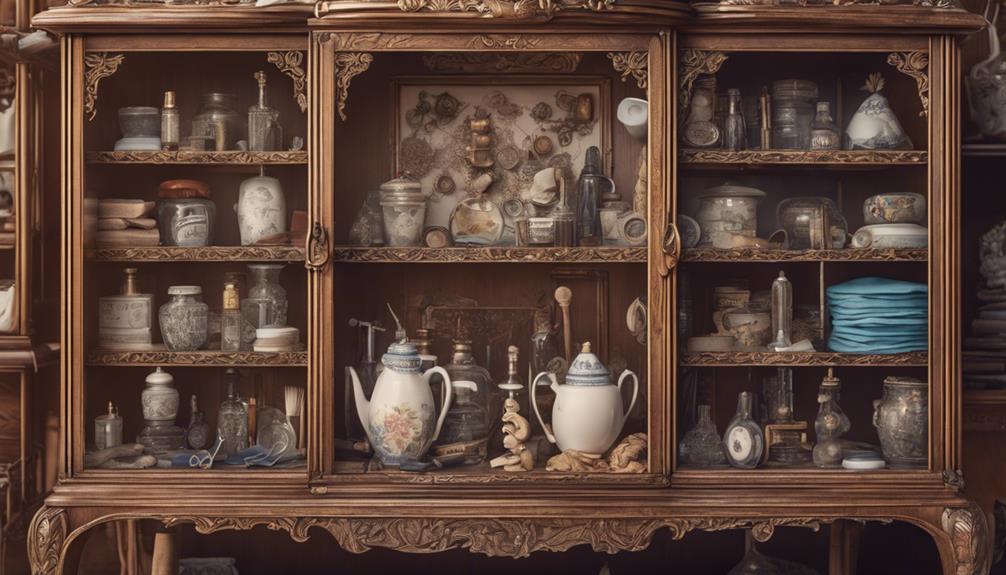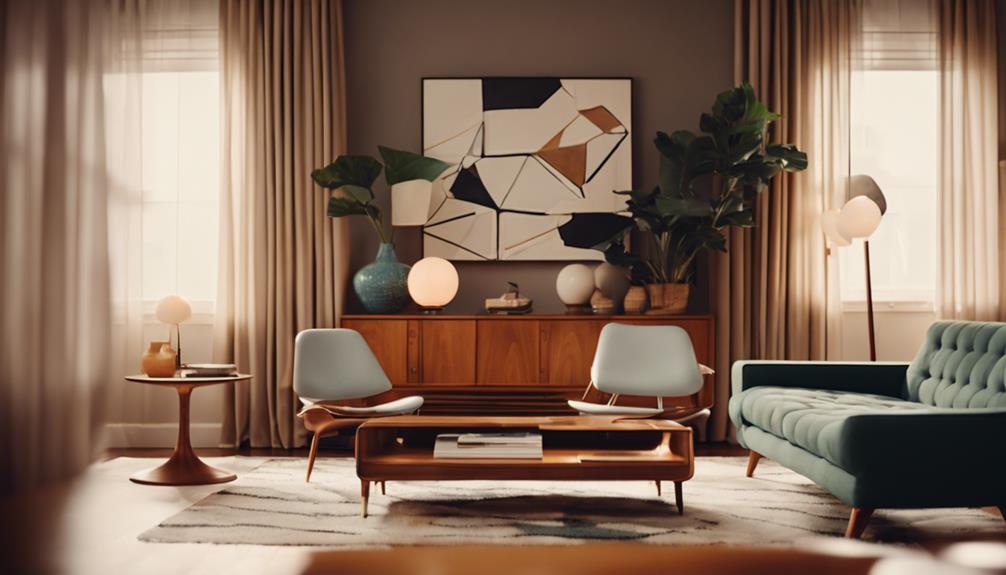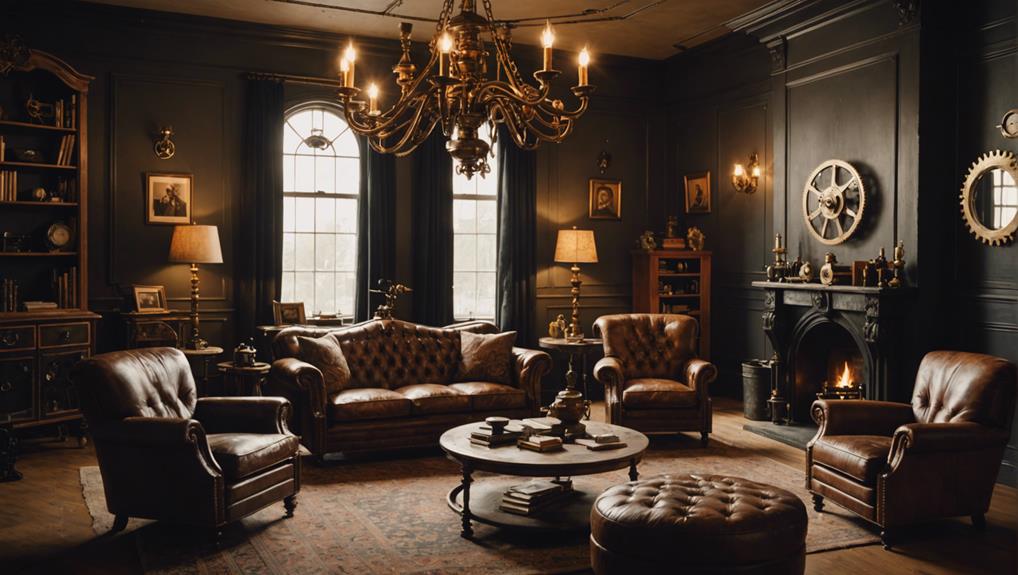We're about to breathe new life into our antique china cabinet. First, we assess the damage and prioritize repairs, filling gaps with wood filler and smoothing surfaces with a sander. Then, we disassemble the cabinet, cleaning and inspecting hardware, and storing it for reinstallation. Next, we tackle hardware repair and replacement, ensuring functionality and design alignment. Surface repair involves filling dents and scratches with wood filler or Bondo, sanding, and priming. Sanding and smoothing techniques bring out the original wood, followed by painting and adding finishing touches. Finally, we reassemble and inspect our restored cabinet. Now, let's dive deeper into the expert techniques that will make our antique china cabinet shine again.
Key Takeaways
• Prioritize repairs by scrutinizing the cabinet for damage, filling gaps with wood filler, and smoothing surfaces with a sander.
• Disassemble the cabinet carefully, cleaning and inspecting hardware, and storing it for reinstallation.
• Repair or replace damaged hardware, ensuring functionality and design alignment, and upgrading to modern equivalents if needed.
• Use wood filler or Bondo to repair surface dents and scratches, sanding down excess filler for a seamless blend.
• Employ expert painting techniques, using high-quality paint, applying it with a brush or sprayer, and adding a protective sealant or topcoat.
Assessing Damage and Creating a Plan
As we begin the restoration process, we must carefully assess the damage to our antique china cabinet. Scrutinizing every inch for broken parts, unstable hardware, dings, dents, and loose joints is essential to create a thorough plan of attack. This step is vital in determining the extent of the repairs needed to bring our treasured piece back to its former glory.
We'll examine each shelf, drawer, and door, making note of any areas that require special attention. Once we've identified the problem areas, we can start prioritizing repairs. We'll fill in gaps with wood filler or epoxy putty, and use a random orbital sander to smooth out surfaces. This will establish a solid foundation for the rest of the restoration process.
Disassembling and Cleaning the Cabinet

As we begin disassembling and cleaning our antique china cabinet, we'll start by removing hardware components, taking care to dust and vacuum the interior to prevent any debris from causing damage.
Next, we'll identify any loose joints that need attention, ensuring our restoration process gets off to a strong start.
Removing Hardware Components
We begin by carefully extracting every last piece of hardware from our antique china cabinet, taking care not to scratch or damage the surrounding woodwork. This is an important step in the restoration process, as it allows us to lovingly restored our cabinet to its former glory. Using a cordless screwdriver, we remove knobs, hinges, and screws, making sure to keep track of each piece and its corresponding location.
We'll need to remember where everything goes when it's time to reassemble our cabinet. Next, we clean each hardware component thoroughly with a mild solution to remove dirt, grime, and old finishes. We inspect each piece for damage or missing parts that may need replacement or repair. Finally, we store the cleaned hardware components in labeled containers, making it easier to locate and reinstall them later.
Dusting and Vacuuming Interior
With the hardware components removed and cleaned, we disassemble the antique china cabinet to access its interior surfaces, allowing us to thoroughly clean and inspect every nook and cranny. This is an important step, as it gives us a chance to truly appreciate the intricate details of the cabinet.
We've been doing this for a long time, and we understand that a quick work of dusting and vacuuming can make all the difference. Using a vacuum cleaner with a brush attachment, we carefully remove dust, debris, and any spider eggs that may have accumulated over the years. We pay close attention to corners, crevices, and intricate details to ensure a thorough cleaning process.
This step is vital in preparing the cabinet for restoration work, as it helps reveal the true condition of the cabinet and aids in evaluating necessary repairs. By doing so, we can pinpoint areas that need special attention, making the restoration process more effective.
Identifying Loose Joints
Now that the interior surfaces are clean, we'll shift our attention to the cabinet's structural integrity by carefully disassembling it to identify and address any loose joints. This vital step guarantees our antique china cabinet is stable and secure.
We'll take apart the cabinet, inspecting each joint for signs of wear, damage, or instability. Any dirt, grime, or old adhesive will be meticulously cleaned from the disassembled parts to make sure of a fresh start.
We'll then reassemble the cabinet, using appropriate wood glue and clamps to guarantee all joints are tight, secure, and aligned properly. This process requires patience and attention to detail, but it's essential for a successful restoration.
Repairing and Replacing Hardware

When restoring our antique china cabinet, we must pay close attention to the hardware. Preserving the cabinet's original charm and functionality is vital. We need to make sure that all hinges, knobs, and pulls are functional and in line with the cabinet's design aesthetic for a cohesive look.
If we find any loose nails or screws, we carefully remove them, apply wood glue, and secure them back in place for stability. We also clean and polish existing hardware to restore its shine and remove any tarnish or buildup from years of use.
If some hardware is beyond repair, we consider upgrading to modern equivalents that maintain the antique look. It's crucial to replace missing or damaged hardware with authentic antique-style pieces to maintain the cabinet's original charm.
Filling Dents and Scratches

Frequently, we encounter dents and scratches on our antique china cabinet that demand attention to restore its original beauty.
To tackle these imperfections, we turn to wood filler or Bondo wood filler. We apply the filler generously, allowing it to fully dry before sanding down the excess to create a smooth surface.
For larger gashes or holes, we consider using epoxy putty for a more substantial repair. Once the filler is dry, we sand the filled areas with different grits of sandpaper to blend them seamlessly with the rest of the surface. This process guarantees a flawless finish.
Before painting or staining our antique china cabinet, we prime the repaired areas to secure a uniform look.
Sanding and Smoothening the Surface

As we move forward with restoring our antique china cabinet,
we'll focus on sanding and smoothening the surface to achieve a flawless finish.
We'll explore the importance of removing old finishes,
the techniques for sanding effectively,
and how to achieve a silky-smooth surface.
By following these steps,
we'll be able to create a beautiful, polished surface
that showcases the cabinet's original beauty.
Removing Old Finish
We start the restoration process by sanding the surface of our antique china cabinet, an essential step that helps strip away the old finish and reveal the original wood underneath. This process is important in removing the old finish, allowing us to start with a clean slate.
As we sand, we're not only removing the old finish but also smoothing out the surface, eliminating scratches, dents, and imperfections. By doing so, we're preparing the cabinet for a fresh coat of stain or paint, ensuring a professional-looking result.
We use different grits of sandpaper to achieve a smooth, even surface. It's a time-consuming process that requires patience and attention to detail, but it's worth the effort. Proper sanding techniques are essential in ensuring the quality and longevity of the final finish.
As we work, we're careful to remove any remaining old finish, making sure the surface is clean and even. By doing so, we're setting ourselves up for success, ensuring our antique china cabinet looks like new again.
Sanding Techniques Explained
With our surface prepped and old finish removed, we can now focus on refining the surface by employing effective sanding techniques to achieve a silky smooth finish.
Sanding is an essential step in restoring our antique china cabinet, as it helps remove imperfections and prepares the surface for refinishing. We start by using a coarse grit sandpaper to remove any remaining old varnish or paint, then progress to finer grits for a smoother surface.
For efficiency and consistency, we use a sanding block or electric sander on flat surfaces, making sure to cover the entire area. However, when it comes to edges and intricate areas, we switch to hand-sanding to maintain the original contours and details of the cabinet.
By paying attention to detail and using the right techniques, we can achieve a professional finish, ensuring the wood is prepped and ready for staining or painting.
With sanding, we're one step closer to giving our antique china cabinet a new lease on life.
Smooth Surface Achieved
By the time we've completed the sanding process, our antique china cabinet's surface is transformed, boasting a silky smooth finish that's free of imperfections and ready for refinishing. We've successfully removed old finishes, smoothed out imperfections, and prepared the wood for its new look.
Using different grits of sandpaper, from coarse to fine, guaranteed a smooth and even surface, free of scratches and blemishes. Whether we chose to sand by hand or with a power sander, we achieved precision in removing old stains, scratches, and uneven areas on the cabinet.
Now, the surface is a clean canvas, ready for applying stains, paints, or other finishes to restore the cabinet's original beauty. We made sure to follow proper sanding techniques, such as following the wood grain and applying consistent pressure, to achieve a professional-looking finish.
With a smooth surface, we can confidently move forward with refinishing, knowing our hard work will pay off in the end.
Painting and Adding Finishing Touches

Now that the preparation work is complete, it's time for us to transform our antique china cabinet with a fresh coat of paint and some stylish finishing touches. To achieve a professional finish, we'll use high-quality paint suitable for wood surfaces. We'll apply the paint using a brush or sprayer, paying attention to details like corners and edges. To guarantee a smoother finish, we'll sand between coats of paint.
| Technique | Purpose |
|---|---|
| Brush application | Even coat distribution |
| Sprayer application | Smooth, uniform finish |
| Sanding between coats | Smoother finish, better paint adhesion |
After painting, we'll add decorative knobs or handles to enhance the overall look of our restored antique china cabinet. Finally, we'll apply a protective sealant or topcoat to preserve the paint and protect the wood surface from damage. With these finishing touches, our antique china cabinet will look like new, ready to be reassembled and admired.
Reassembly and Final Inspection

We've added the final flourishes to our antique china cabinet, and it's time to bring all the carefully restored components together, guaranteeing a precise and secure reassembly.
As we reassemble the cabinet, we'll make certain all parts fit snugly and securely, with no loose screws, hinges, or structural issues.
Here's our final checklist:
- Verify that all doors close properly and align correctly with the cabinet frame.
- Inspect the glass panels for any cracks, chips, or imperfections that may impact the cabinet's overall appearance.
- Conduct a thorough inspection to check for any loose screws, hinges, or structural issues.
- Double-check the overall stability and functionality of the restored cabinet before considering the restoration process complete.
- Ensure all components are securely attached and functioning as intended.
With these final steps complete, we can confidently say our antique china cabinet has been fully restored to its former glory. Its beauty and functionality have been expertly revived, and it's ready to take pride of place in any home.
Frequently Asked Questions
How Do You Make an Old China Cabinet Look New?
We revamp an old china cabinet by tackling imperfections first. We sand down worn surfaces, repair damages, and apply a fresh coat of stain or paint to revitalize its appearance.
Next, we replace missing doors with quality wood and add glass panels for elegance. We meticulously add trim pieces that match the original pattern, ensuring authenticity.
How to Restore an Antique?
We begin by evaluating the antique's condition, researching its history and origin to guide our restoration process.
We address structural damage, such as broken parts or loose joints, before moving on to cosmetic enhancements.
Employing traditional techniques like wood filling, sanding, and refinishing, we restore the original beauty of the antique.
How Do You Clean Old China Cabinets?
When it comes to cleaning old china cabinets, we start by gently dusting the surface with a soft cloth to remove dirt and debris.
For tougher stains, we use a mild soap and water solution, avoiding harsh chemicals that could damage the wood finish.
We also inspect and clean glass panels with a glass cleaner for a polished look.
What Should I Do With My China Cabinet?
We're faced with a dilemma: what to do with our cherished china cabinet.
Rather than letting it collect dust, we can breathe new life into it. We could repurpose it as a bar, bookcase, or entertainment center, fitting it to our home's unique needs.
With a little creativity and some TLC, we can transform this antique piece into a stunning addition that showcases our craftsmanship and dedication to preserving history.
Conclusion
With our expert restoration techniques, your antique china cabinet is reborn, its beauty and functionality restored like a phoenix rising from the ashes.
We've carefully assessed the damage, disassembled and cleaned the cabinet, repaired and replaced hardware, filled dents and scratches, and sanded and smoothed the surface.
Finally, we've added a fresh coat of paint and reassembled the piece, breathing new life into this treasured heirloom.









